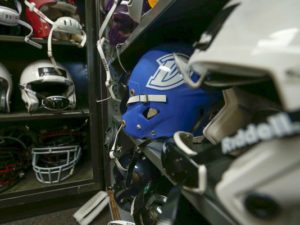By Matthew Patane (mpatane@dmreg.com), Des Moines Register
In a room lined with football helmets, a machine whirs as it raises up one helmet a few feet.
Iowa State University student Zach Murrell counts down — three, two, one — pulls a pin and the helmet drops with a “smack” onto the base of a machine, while a computer measures the impact.
It’s meant to simulate the impact a player might feel from a blow to the head during a football game. The goal — to collect enough data to build a better, safer helmet that can reduce the risk of concussions.
Murrell is dropping helmets for Cross Over, a new company started by Kim Baker and Jerry Janson, two neighbors from Carroll. Janson and Baker aren’t physicians, engineers or brain experts. In fact, Janson is a financial adviser and Baker is a television producer.
But they both care about football and are worried about the future of the sport if safety isn’t improved.
“If we don’t see some kind of a change in the structure of a football helmet, in the safety (of it), you’re going to see the game of football change dramatically,” Janson said.
Janson started talking two years ago about designing a better helmet. The pair took their idea to Iowa State University and began working with engineering students on testing and design.
In June, Iowa State’s new entrepreneurship effort, the Startup Factory, brought Janson and Baker into the program to further develop the company. The two co-founders signed on three students — Murrell, Zach Taalman and Tanner Hamelau — as employees to help with their effort.
A helmet to grow up with
As a first step, Cross Over’s team wants to incorporate new materials into their helmets that would react differently depending on how much force is exerted — figuratively taking the sting out of the football hit.
“The idea is can we come up with some sort of material that will absorb the energy out of that impact and not transfer that into the human body,” said Jim Heise, a senior lecturer of mechanical engineering at the university who is advising Cross Over.
Brain injuries occur not only from direct hits to the head but from repeated small impacts that may not cause concussion but still jostle the brain around the skull, experts say.
Parents and athletic medical personal “are feeling increasingly uneasy” because know one knows how many sub-concussive impacts are too many, said Geoffrey Lauer, executive director of the Brain Injury Alliance of Iowa.
Whenever there is a blow to the head “the brain joggles around in there,” Lauer said.
No helmet or protective gear can be a ‘silver bullet’ to prevent concussions, Lauer said.
“I’ve watched this for 20 years now, and I applaud anybody who tries to develop a better safety device. … On the other hand, there is no helmet or protective device that is going to substantively reduce or eliminate concussions in contact sports,” he said.
Helmets today only diffuse the energy from a hit, agreed Andrew Peterson, a clinical assistant professor at the University of Iowa and team physician for the Hawkeyes.
“The only way to prevent concussions at this point is to limit hitting,” Peterson said.
The Cross Over goal
Baker said eliminating concussions entirely is not his company’s immediate goal.
Cross Over wants its helmets to reduce the risk of long-term brain injuries from repeated head collisions that aren’t serious enough to cause concussions.
It hopes to have a prototype ready to use on the football field by spring 2017, Baker said.
Its first helmets likely would be tested by youth athletes during practices, when collisions are less fierce.
Once that work is done, Baker said Cross Over will work to license and manufacture its helmets.
Eventually, Cross Over hopes to integrate technology such as sensors to make the helmets smarter and more protective.
Baker said Cross Over has been self-funding the work, with help from Iowa State. Without that support, he said Cross Over’s costs would be in the six-figure range so far.
The company may pursue grants, including state funding, as well as investors.
Addressing parents’ fears
If they are successful, it could help a sport that appears to have more parents wondering if it is worth the risks.
In Iowa, 18,158 students participated in 11-player football during the 2014-15 school year, compared with 20,420 in the 2008-09 school year.
Moreover, a February Des Moines Register/Mediacom Iowa Poll showed 42 percent of Iowans would not allow their child to play competitive football.
CTE and Iowa
The dangerous effects of contact sports, including brain injuries, has had increased attention with the advent of chronic traumatic encephalopathy, or CTE.
CTE is a degenerative brain disease tied to repeated head injuries. The disease can cause memory loss, depression, emotional instability and aggression, among other potential symptoms, according to the Centers for Disease Control and Mayo Clinic.
The disease has been connected to football players, but how commonplace it is is difficult to determine. CTE can only currently be diagnosed after death during an autopsy.
Tyler Sash, the former University of Iowa defensive back and player for the New York Giants, died last September due to a deadly mixture of drugs. Later, though, testing revealed Sash suffered from the brain disease.
The family for Zac Easter recently held a forum to discuss their son and the disease. Easter received multiple concussions while playing high school football in Indianola and had written about his struggle with CTE.
He died in December at the age of 24.


Recent Comments